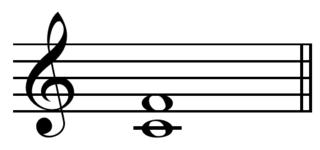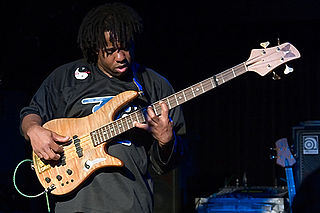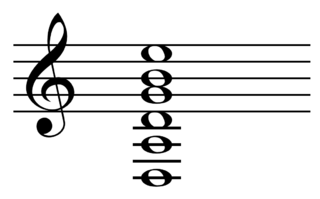
The guitar is a stringed musical instrument that is usually fretted and typically has six or twelve strings. It is usually held flat against the player's body and played by strumming or plucking the strings with the dominant hand, while simultaneously pressing selected strings against frets with the fingers of the opposite hand. A guitar pick may also be used to strike the strings. The sound of the guitar is projected either acoustically, by means of a resonant hollow chamber on the guitar, or amplified by an electronic pickup and an amplifier.

In music performances, rhythm guitar is a technique and role that performs a combination of two functions: to provide all or part of the rhythmic pulse in conjunction with other instruments from the rhythm section ; and to provide all or part of the harmony, i.e. the chords from a song's chord progression, where a chord is a group of notes played together. Therefore, the basic technique of rhythm guitar is to hold down a series of chords with the fretting hand while strumming or fingerpicking rhythmically with the other hand. More developed rhythm techniques include arpeggios, damping, riffs, chord solos, and complex strums.

A fourth is a musical interval encompassing four staff positions in the music notation of Western culture, and a perfect fourth is the fourth spanning five semitones. For example, the ascending interval from C to the next F is a perfect fourth, because the note F is the fifth semitone above C, and there are four staff positions between C and F. Diminished and augmented fourths span the same number of staff positions, but consist of a different number of semitones.

A power chord, also called a fifth chord, is a colloquial name for a chord on guitar, especially on electric guitar, that consists of the root note and the fifth, as well as possibly octaves of those notes. Power chords are commonly played with an amp with intentionally added distortion or overdrive effects. Power chords are a key element of many styles of rock, especially heavy metal and punk rock.

In music, a chord is a group of two or more notes played simultaneously, typically consisting of a root note, a third, and a fifth. Chords are the building blocks of harmony and form the harmonic foundation of a piece of music. They can be major, minor, diminished, augmented, or extended, depending on the intervals between the notes and their arrangement. Chords provide the harmonic support and coloration that accompany melodies and contribute to the overall sound and mood of a musical composition. For many practical and theoretical purposes, arpeggios and other types of broken chords may also be considered as chords in the right musical context.

Bassline is the term used in many styles of music, such as blues, jazz, funk, dub and electronic, traditional, and classical music, for the low-pitched instrumental part or line played by a rhythm section instrument such as the electric bass, double bass, cello, tuba or keyboard.

In the music theory of harmony, the root is a specific note that names and typifies a given chord. Chords are often spoken about in terms of their root, their quality, and their extensions. When a chord is named without reference to quality, it is assumed to be major—for example, a "C chord" refers to a C major triad, containing the notes C, E, and G. In a given harmonic context, the root of a chord need not be in the bass position, as chords may be inverted while retaining the same name, and therefore the same root.
In music theory, a dominant seventh chord, or major minor seventh chord, is a seventh chord, composed of a root, major third, perfect fifth, and minor seventh. Thus it is a major triad together with a minor seventh, denoted by the letter name of the chord root and a superscript "7". In most cases, dominant seventh chord are built on the fifth degree of the major scale. An example is the dominant seventh chord built on G, written as G7, having pitches G–B–D–F:

Drop D tuning is an alternative form of guitar tuning in which the lowest (sixth) string is tuned down from the usual E of standard tuning by one whole step to D. So where standard tuning is E2A2D3G3B3E4 (EADGBe), drop D is D2A2D3G3B3E4 (DADGBe). Drop D tuning, as well as other lowered altered tunings, are often used with the electric guitar in heavy metal music. It is also used in blues, country, folk (often with acoustic guitar), and classical guitar.

In music, a guitar chord is a set of notes played on a guitar. A chord's notes are often played simultaneously, but they can be played sequentially in an arpeggio. The implementation of guitar chords depends on the guitar tuning. Most guitars used in popular music have six strings with the "standard" tuning of the Spanish classical guitar, namely E–A–D–G–B–E' ; in standard tuning, the intervals present among adjacent strings are perfect fourths except for the major third (G,B). Standard tuning requires four chord-shapes for the major triads.

Guitar tunings are the assignment of pitches to the open strings of guitars, including classical guitars, acoustic guitars, and electric guitars. Tunings are described by the particular pitches that are made by notes in Western music. By convention, the notes are ordered and arranged from the lowest-pitched string to the highest-pitched string, or the thickest string to thinnest, or the lowest frequency to the highest. This sometimes confuses beginner guitarists, since the highest-pitched string is referred to as the 1st string, and the lowest-pitched is the 6th string.

Chuck Wayne was an American jazz guitarist. He came to prominence in the 1940s, and was among the earliest jazz guitarists to play in the bebop style. Wayne was a member of Woody Herman's First Herd, the first guitarist in the George Shearing quintet, and Tony Bennett's music director and accompanist. He developed a systematic method for playing jazz guitar.

Each bass guitar tuning assigns pitches to the strings of an electric bass. Because pitches are associated with notes, bass-guitar tunings assign open notes to open strings. There are several techniques for accurately tuning the strings of an electric bass. Bass method or lesson books introduce one or more tuning techniques, such as:
In music theory, an inversion is a rearrangement of the top-to-bottom elements in an interval, a chord, a melody, or a group of contrapuntal lines of music. In each of these cases, "inversion" has a distinct but related meaning. The concept of inversion also plays an important role in musical set theory.

The Stradella Bass System is a buttonboard layout equipped on the bass side of many accordions, which uses columns of buttons arranged in a circle of fifths; this places the principal major chords of a key in three adjacent columns.

This is a glossary of jazz and popular music terms that are likely to be encountered in printed popular music songbooks, fake books and vocal scores, big band scores, jazz, and rock concert reviews, and album liner notes. This glossary includes terms for musical instruments, playing or singing techniques, amplifiers, effects units, sound reinforcement equipment, and recording gear and techniques which are widely used in jazz and popular music. Most of the terms are in English, but in some cases, terms from other languages are encountered.
Musicians use various kinds of chord names and symbols in different contexts to represent musical chords. In most genres of popular music, including jazz, pop, and rock, a chord name and its corresponding symbol typically indicate one or more of the following:
- the root note,
- the chord quality,
- whether the chord is a triad, seventh chord, or an extended chord,
- any altered notes,
- any added tones, and
- the bass note if it is not the root.

Among alternative tunings for guitar, a major-thirds tuning is a regular tuning in which each interval between successive open strings is a major third. Other names for major-thirds tuning include major-third tuning, M3 tuning, all-thirds tuning, and augmented tuning. By definition, a major-third interval separates two notes that differ by exactly four semitones.

Among alternative guitar-tunings, regular tunings have equal musical intervals between the paired notes of their successive open strings.

Among alternative tunings for the guitar, an overtones tuning selects its open-string notes from the overtone sequence of a fundamental note. An example is the open tuning constituted by the first six overtones of the fundamental note C, namely C2-C3-G3-C4-E4-G4.



















